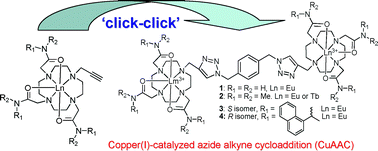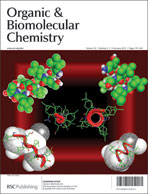The design and synthesis of dinuclear-lanthanide complexes possessing triazole-based bridges, formed by using copper catalysed 1,3-cycloaddition reactions between heptadentate alkyne functionalised cyclen europium or terbium complexes and di-azides (CuAAC reactions), are described. While this click reaction worked well for the formation of the homo-Eu(III) and Tb(III) bis-tri-arm cyclen N,N-dimethyl acetamide complexes, 2Eu and 2Tb, and for the homo-Eu(III) chiral N-methylnaphthalene based complexes 3Eu (S,S,S) and 4Eu (R,R,R), the formation of the Eu(III) complex of the primary amide analogue of 2, namely 1Eu, was not successful, clearly demonstrating the effect that the nature of the pendant arms has on this reaction. Furthermore, the click reactions between the free alkyne cyclen bis-derivatives (5–8) and the di-azide were unsuccessful, most likely due to the high affinity of the cyclen macrocycles for Cu(II). The Eu(III) complexes of 2–4 and 2Tb all gave rise to sensitised metal ion centred emission upon excitation of the triazole or the naphthalene antennae in methanol solution, and their hydration states were determined, which showed that while the Eu(III) mono-nuclear complexes had q ∼ 2, the click products all had q ∼ 1. In the case of 3Eu (S,S,S) and 4Eu (R,R,R), the circular polarised emission (CPL) was also observed for both, demonstrating the chiral environment of the lanthanide centres.


 Please wait while we load your content...
Please wait while we load your content...